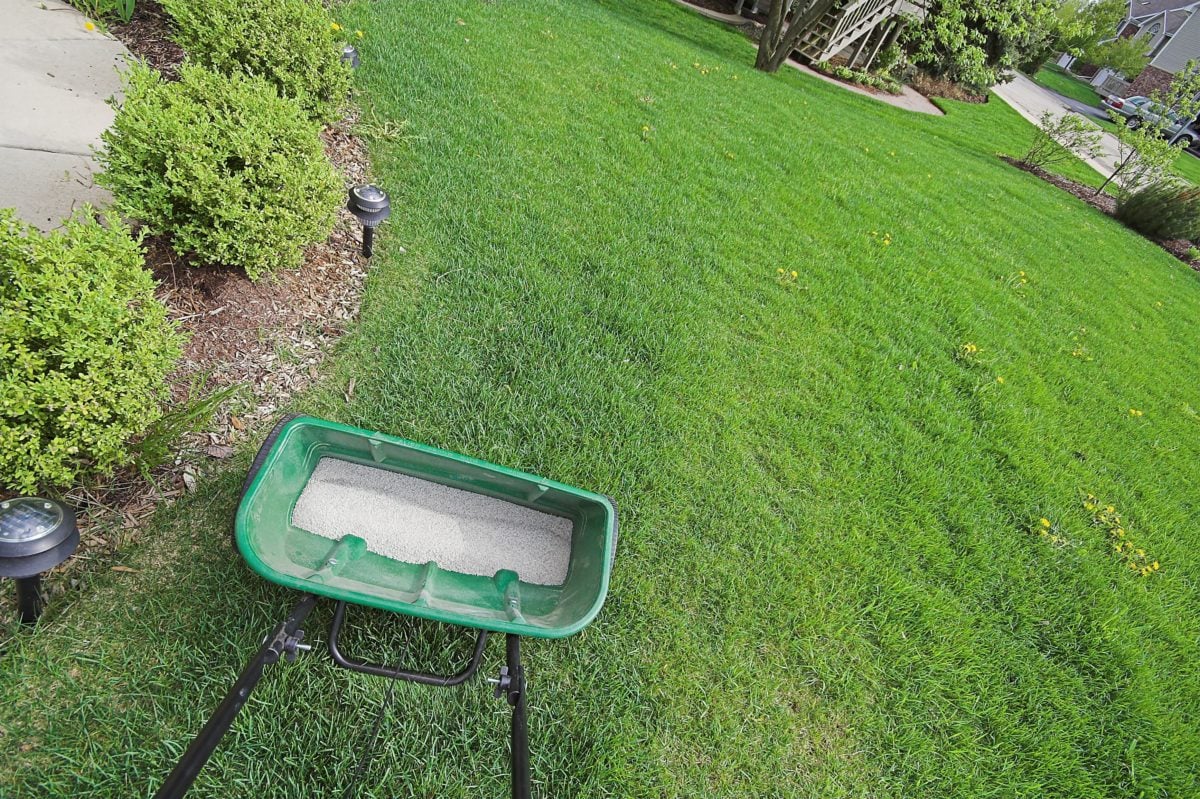
Whether you are planting new grass from scratch or repairing bare spots, figuring out a proper fertilizer to get your lawn off to the best start can be daunting. Here are the answers to nine FAQs about applying starter fertilizer to your lawn.
One look at your local garden center’s fertilizer aisle and you’re inundated with choices for producing your vibrant lawn. We’ve taken the mystery out of starter fertilizers for you.
Our Top Picks for Starter Fertilizers:
- 1. What is Starter Fertilizer?
- 2. What is a Good Starter Fertilizer for Grass Seed and Sod?
- 3. Can you Apply a Starter Fertilizer to Grass Seed and Sod?
- 4. Is it Best to Get a Soil Test First to See Phosphorus Levels?
- 5. Is There a Standard Amount of Starter Fertilizer I Should Use?
- 6. Are There Circumstances Where you Shouldn’t Use a Starter Fertilizer?
- 7. When Should you Apply Starter Fertilizer?
- 8. Can I Use a Starter Fertilizer on an Established Lawn?
- 9. How Do You Apply Starter Fertilizer?
- Phosphorus as a Fertilizer for Newly Seeded Lawns
- Nitrogen, Organic Matter, and a New Lawn
1. What is Starter Fertilizer?
Starter lawn fertilizer is a small quantity of fertilizer nutrients applied near the seed at planting. It helps your grass seedlings and sod roots establish more rapidly in the soil than regular fertilizer, leading to a thick new lawn in a short period. For that reason, starter fertilizers are the best fertilizers for grass seed and newly established sod.
Starter fertilizers for grass may differ slightly in composition, but they all give the grass seeds and new sod the nutritional boost required for healthy germination and rapid root growth. They will usually contain equal amounts of nitrogen, phosphorus, and potassium. However, some types contain two parts of nitrogen and one part of phosphorus and potassium.
You can choose between slow-release and quick-release fertilizers for grass, with the latter delivering a quick green-up dose of nitrogen. It can be applied to all-new lawns, or to help bare spots recover from winterkill or other damage.
What is the Difference Between Starter Fertilizer and Regular Fertilizer?
According to David M. Kopec of the University of Arizona Extension, the main difference is the amount of phosphorus in the fertilizer. Starter fertilizers usually contain 20 percent more phosphorus than regular fertilizers. Because of the higher phosphorus quantities, starter fertilizers are the ideal fertilizer for new lawns.
2. What is a Good Starter Fertilizer for Grass Seed and Sod?
Starter fertilizers for lawns come in different compositions of the primary nutrients nitrogen (N), phosphorus (P-phosphate), and potassium (K-potash), or the three numbers listed on the package (NPK ratio).
The starter fertilizer numbers list the percentage of each nutrient it contains. For example, a 10-10-10 fertilizer for new sod contains 10 percent each of nitrogen (N), phosphorus (P), and potassium (K).
When it comes to the specific job of each of these primary nutrients in regards to the health of your turf:
- Nitrogen: Is required for satisfactory growth and green coloration.
- Phosphorous: Plays an important role in various growth processes including good root development.
- Potassium: Promotes good disease resistance, tolerance of drought, and winter hardiness in turfgrass.
Some examples of the formulations of common lawn starter fertilizers for new grass are 10-10-10, 20-10-10, and 16-8-8. Penn State Extension notes that analyses of 15-10-10 or 10-6-4 are also acceptable used as starter fertilizers for grass, as they also promote good early growth and grass development.
3. Can you Apply a Starter Fertilizer to Grass Seed and Sod?
“Yes, both seed and sod,” states Peter Landschoot, Ph.D., professor of turfgrass science at Penn State Extension.
Seed: At the seedling stage, “Grasses need greater amounts of nitrogen and phosphorus than mature grass plants because seedlings are producing new tissues rapidly and thus have higher energy and nutrition requirements.” Overseeding a lawn will take more time, but sod will be more expensive.
Sod: “Even though sod is mostly composed of mature turf, many of the roots have been severed during the harvesting operation,” Landschoot says. Some nitrogen and phosphorus (as starter fertilizer) applied to the soil before the sod is laid should help hasten the development of new roots.”
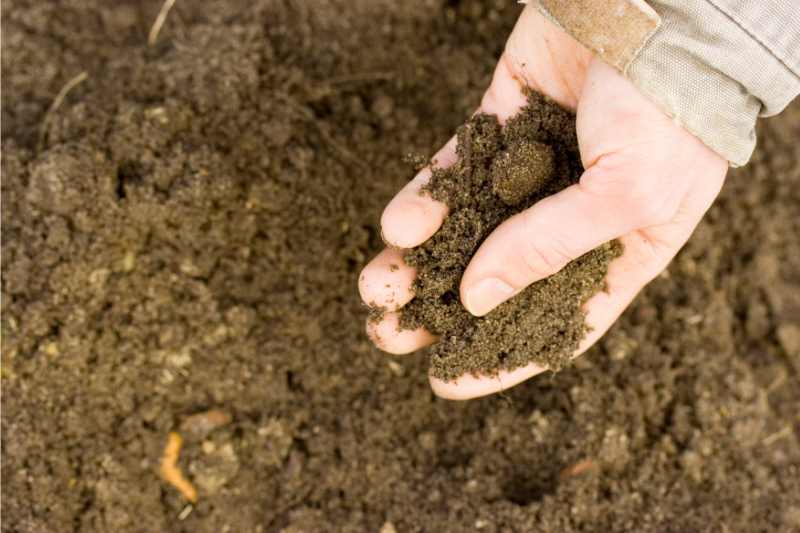
4. Is it Best to Get a Soil Test First to See Phosphorus Levels?
Landschoot notes, “Because soil-test levels of phosphorus don’t change much over short periods, you can collect soil samples and submit them to a test lab to determine phosphorus levels within a year of establishing turf.”
Nearly all extension service offices offer low-cost soil testing services. Check with your local Cooperative Extension Office for details. Soil samples can be collected at any time during the year as long as the soil is not frozen. Ideally, you want to collect soil and submit the sample(s) to a test lab as close to the time of establishment as possible.
Pro Tip: Make sure to leave time to get the test back with the phosphorus and other recommendations. It can take 1-3 days or up to two weeks to get results, depending on the test. You’ll need a few extra days to buy fertilizer for new sod and make necessary adjustments to the soil before planting your new lawn.

5. Is There a Standard Amount of Starter Fertilizer I Should Use?
If you didn’t get a soil test to determine how much starter fertilizer to use for your lawn, Landschoot offers these general recommendations:
- “Starter fertilizers should be applied at 0.5 to 1 lb. nitrogen per 1,000 square feet. Amounts in excess of 1.5 lb. nitrogen per 1,000 square feet can burn the young turf and result in poor establishment.”
Quick-release nitrogen will speed up seedling development.
Pro Tip: Landschoot notes, “Application of a starter fertilizer is not a substitute for the phosphate and potash recommended on your soil test report.”
6. Are There Circumstances Where you Shouldn’t Use a Starter Fertilizer?
- You should not use starter fertilizer in areas where you cannot control runoff. Nitrogen and phosphorus from indiscriminate use of fertilizers have caused such great environmental concerns that about half the states in the U.S. have imposed regulations on fertilizer use.
- Don’t use starter fertilizer if your soil test shows it’s not needed. Instead, apply 1-2 inches of organic fertilizer, such as a biosolids fertilizer or manure-based compost, and work into the soil before establishing your new turf. These amendments contain significant amounts of nitrogen and phosphorus to get your new lawn off to a healthy start.
Pro Tip: It’s common for homeowners to apply lawn fertilizer, depending on where they live, in the spring, but not before the grass greens up.
When to Apply Fertilizer in Established Lawns
Once your healthy lawn has been established, fertilize every six to eight weeks. The best time is late spring for warm-season grasses (e.g., centipedegrass, St. Augustinegrass, and Zoysiagrass) and fall for cool-season grasses (e.g., Kentucky bluegrass, tall fescue, and fine fescues).
Follow good lawn care maintenance such as aeration and mowing heights to keep your lawn healthy and beautiful.
Does Starter Fertilizer Work for All Grass Types?
Yes, starter fertilizer works for fescues and other cool-season grasses, as well as warm-season turfgrasses.
7. When Should you Apply Starter Fertilizer?
You should fertilize before seeding or laying sod, or after you plant the new grass seed. You don’t want to apply it directly to newly planted sod or burning can occur.
Note: Wait six to eight weeks before applying another dose of balanced fertilizer to your grass after planting so it doesn’t burn the grass.
How Much Starter Grass Fertilizer Should you Apply?
Take a soil test to know how much starter fertilizer you’ll need for the grass. The three most important nutrients required for good growth and health of your turfgrass are nitrogen, phosphorus, and potassium, which a starter fertilizer contains.
It’s best to till the fertilizer for new seed 4 to 6 inches into the soil along with any additional soil amendments you are adding. You can also spread it over the site immediately after planting your new grass seed.
Pro Tip: When phosphorus and potassium are applied only to the surface of the soil they cannot move down into the soil fast enough and nitrogen can easily be leached out before the grass even has a chance to uptake its nutrients.
8. Can I Use a Starter Fertilizer on an Established Lawn?
Probably not. Although you can put starter fertilizer on existing grass, it’s better to use a well-balanced fertilizer designed specifically for grass that is established.
Starter fertilizer might not contain all the required nutrients for continued growth and good health. It won’t hurt the grass but might lack the needed nutrients that a well-balanced fertilizer for continued lawn maintenance contains.
9. How Do You Apply Starter Fertilizer?
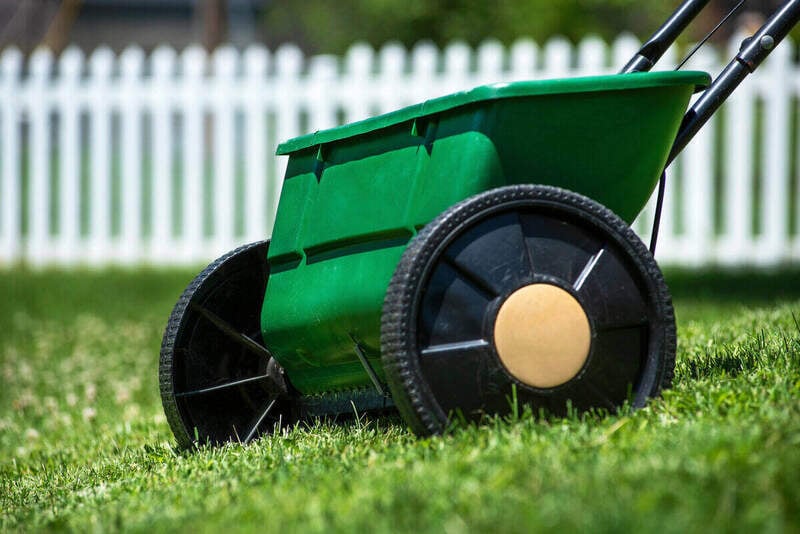
If you’re planting sod, apply starter fertilizer before you put down the sod. If you’re planting seed, apply a fertilizer either before or after planting the seed. There are lawn seed and fertilizer mixes in the market that can make the process even more practical. Here are the tips for successfully fertilizing new grass:
- If you apply starter fertilizer before planting grass seed or sod: Pour the required amount into a standard fertilizer spreader and evenly apply the sod starter fertilizer over the planting site. Once applied, work the product 4 to 6 inches into the soil.
- If you apply starter fertilizer after you’ve planted grass seed: Use the fertilizer spreader and apply it over the soil. Then water in the grass seed starter.
There are different types of fertilizer applications. You can choose between liquid or granular. Both supply the essential nutrients; however, Michigan State University recommends liquid fertilizers.
Granular fertilizers can be inconsistent in spreading and can be “hot,” burning young plants that are nearby. Follow the directions on your chosen fertilizer to verify the best application process.
Pro Tip: If you’re overseeding or using sod, avoid weed and feed fertilizers for four weeks or until your third mowing. The herbicides may prevent root development in your new grass seeds.
Wait Time: On average, fertilized grass seed takes about 10 to 14 days to germinate, but it can take up to 30 days.
Phosphorus as a Fertilizer for Newly Seeded Lawns
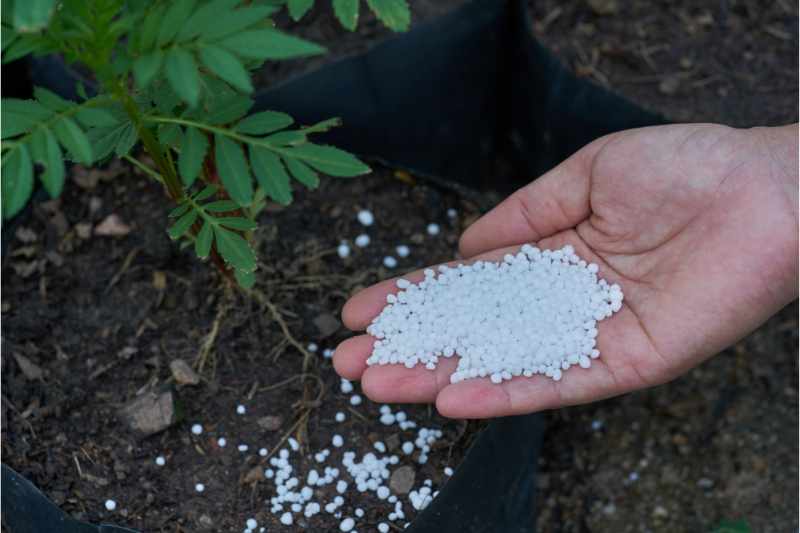
When it comes to explaining phosphorus and its role, Landschoot notes, ”Phosphorus is included in starter fertilizer primarily to enhance root development.” This explains why starter fertilizer is typically the best fertilizer for a newly established lawn.
But there is some controversy: “Some research shows little influence of phosphorus on turf establishment in soils containing adequate to high levels of soil-test phosphorus; whereas other studies show benefits even when phosphorus levels are adequate.”
Either way, he concludes that: “Generally, developing seedlings growing in compact soils during cold temperatures are thought to benefit more from phosphorus in starter fertilizer.”
Nitrogen, Organic Matter, and a New Lawn
If your lawn is not rich in natural organic matter, nitrogen plays an important role. Landschoot notes, “In cases where soils are not amended with compost, nitrogen is almost always needed for rapid establishment.
Our research shows a greater influence of nitrogen compared to phosphorus on the rate of turf establishment, so if you can’t use phosphorus (or you think there is enough phosphorus in the soil), an application of 1 lb. quick-release nitrogen per 1,000 square feet will speed up seedling development.”
Hire a Professional
If you’re a homeowner who isn‘t down to DIY or you’re frustrated with the progress of your garden oasis, you can hire a lawn care professional to get your dream lawn started while you relax.
Disclaimer: This information is for educational use only. Consider consulting a local exterminator for professional advice.
LawnStarter participates in Get Sunday’s affiliate advertising program. LawnStarter may earn revenue from products promoted in this article.
Main image credit: Jay Crihfield / Adobe Stock

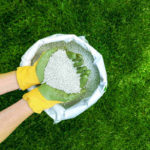
![5 Best Fertilizers for Bermudagrass in 2022 [Reviews]](https://www.lawnstarter.com/blog/wp-content/uploads/2023/12/Best-Fertilizers-for-Bermudagrass-150x150.jpg)
![7 Best Fertilizers for Grass in 2022 [Reviews]](https://www.lawnstarter.com/blog/wp-content/uploads/2023/12/Best-Fertilizers-for-Grass-150x150.jpg)
![5 Best Fertilizers for St. Augustinegrass in 2022 [Reviews]](https://www.lawnstarter.com/blog/wp-content/uploads/2024/01/Best-Fertilizers-for-St.-Augustinegrass-3-150x150.jpg)
![8 Best Fertilizer Spreaders of 2022 [Reviews]](https://www.lawnstarter.com/blog/wp-content/uploads/2024/01/Best-Fertilizer-Spreaders-150x150.jpg)